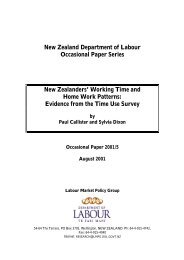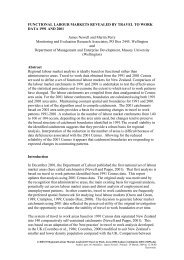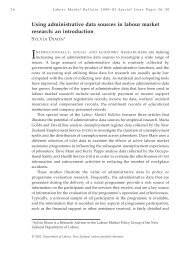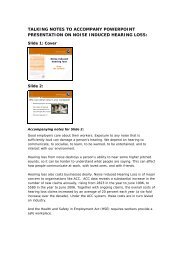Potential Output: Concepts and Measurement - Department of Labour
Potential Output: Concepts and Measurement - Department of Labour
Potential Output: Concepts and Measurement - Department of Labour
Create successful ePaper yourself
Turn your PDF publications into a flip-book with our unique Google optimized e-Paper software.
Darren Gibbs 85<br />
simplicity. The approach requires that an assumption be made regarding the<br />
mathematical form <strong>of</strong> the production function. Typically, the Cobb-Douglas <strong>and</strong><br />
CES specifications are used as well as a variety <strong>of</strong> more flexible forms, though<br />
economists have had a great deal <strong>of</strong> difficulty agreeing on which form is best.<br />
Furthermore, in addition to the need to measure the quantity <strong>of</strong> inputs used<br />
in the process (which, as already outlined, is a feature <strong>of</strong> structural approaches),<br />
the approach also requires that some estimate is made <strong>of</strong> the quality <strong>of</strong> factor<br />
inputs. Studies as early as that <strong>of</strong> Solow (1957) have found that the physical<br />
quantity <strong>of</strong> inputs provides a poor explanation <strong>of</strong> actual movements in output.<br />
Indeed, this study found that factor inputs could explain only one-third <strong>of</strong><br />
growth with the ‘Solow residual’ or total factor productivity accounting for the<br />
remainder. It is this residual that captures changes in the quality <strong>of</strong> inputs <strong>and</strong><br />
production processes. As Laxton <strong>and</strong> Tetlow note:<br />
One important advantage <strong>of</strong> the production function approach over the time trend<br />
approach is that it is easy to keep track <strong>of</strong> the major contributing factors to potential<br />
output. That is, variations in its underlying determinants such as labour force<br />
growth, capital formation, <strong>and</strong> trend total factor productivity. For this reason the<br />
production function approach was seen as an attractive framework for organising the<br />
data. However, there remained a problem. Since economists had no useful model <strong>of</strong><br />
the determinants <strong>of</strong> productivity, the resulting estimates were still essentially<br />
exogenous time trends (p 7).<br />
The use <strong>of</strong> ad hoc polynomial time trends as regressors in production functions<br />
to explain productivity (see, for example, Perl<strong>of</strong>f <strong>and</strong> Wachter, 1979), together<br />
with their quantitative importance to the results, constituted a very significant<br />
weakness in the empirical application <strong>of</strong> the production function approach.<br />
Moreover estimates derived from these techniques proved to be very sensitive<br />
to the type <strong>of</strong> approach used. Together these factors severely limited the practical<br />
usefulness <strong>of</strong> the estimates.<br />
Although the recent theoretical development <strong>of</strong> the endogenous growth<br />
literature has provided some insights <strong>and</strong> stimulated debate regarding the<br />
determinants <strong>of</strong> long-run growth, endogenous growth theory has received little<br />
attention in empirical research to date.<br />
Partly in response to the above problems, a new literature emerged in the<br />
early 1980s in which changes in potential output <strong>and</strong> the natural rate <strong>of</strong><br />
unemployment were treated as stochastic (rather than deterministic) phenomena.<br />
3.3 Stochastic filtering techniques<br />
Laxton <strong>and</strong> Tetlow (1992) argue that there is insufficient knowledge about the<br />
true structure <strong>of</strong> the economy to make the structural approach practical.<br />
Moreover, researchers using structural techniques have tended to concentrate on<br />
highly stylised models focusing on specific, easily identifiable shocks, <strong>and</strong> have







![a note on levels, trends, and some implications [pdf 21 pages, 139KB]](https://img.yumpu.com/27285836/1/184x260/a-note-on-levels-trends-and-some-implications-pdf-21-pages-139kb.jpg?quality=85)






![Labour Market Trends and Outlook - 1996 [pdf 18 pages, 94KB]](https://img.yumpu.com/27285764/1/184x260/labour-market-trends-and-outlook-1996-pdf-18-pages-94kb.jpg?quality=85)

